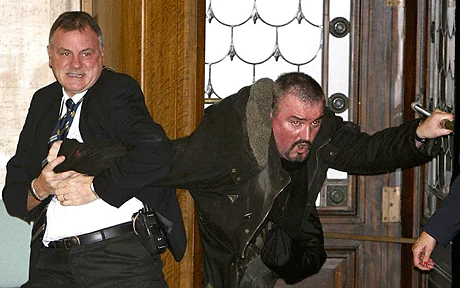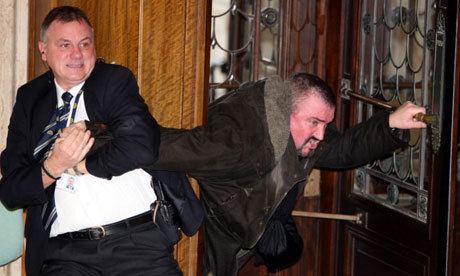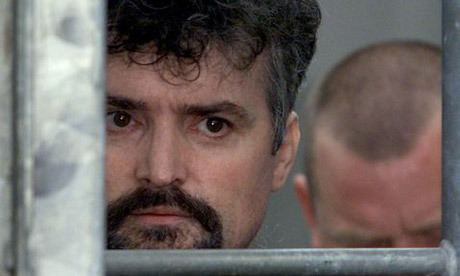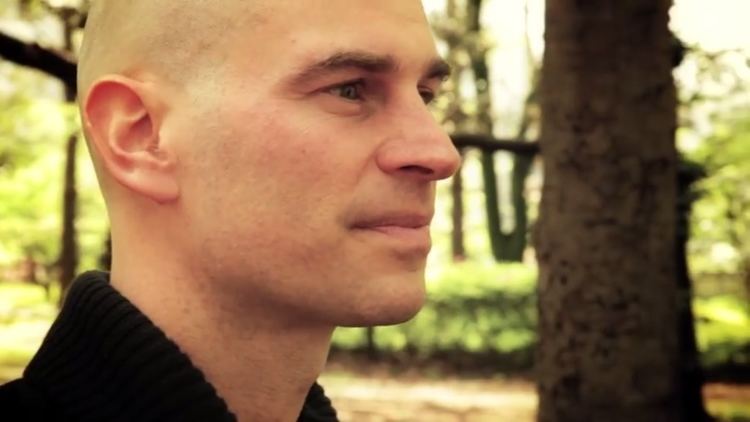Name Michael Stone | Role Writer | |
 | ||
Books None Shall Divide Us: To Some He Is a Hero. the Ira Want Him Dead - This Is the True Story of the Artist Who Was Ireland's Most Notorious Assassin... | ||
Michael stone loyalist
Michael Stone (born 2 April 1955) is an Ulster loyalist who was a volunteer in the Ulster Defence Association (UDA). Stone was born in England but raised in the Braniel estate in East Belfast, Northern Ireland. Convicted of murdering three people and injuring more than 60 in an attack on mourners at Milltown Cemetery in 1988, he was sentenced to life imprisonment. While in jail, he became one of the leaders of the Ulster Defence Association/Ulster Freedom Fighters (UDA/UFF) prisoners.
Contents
- Michael stone loyalist
- Michael stone loyalist hero or psychopath documentary
- Early life story
- Move to loyalism act
- Red Hand Commando
- Return to UDA ulster defence association
- Milltown Cemetery attack
- Release and subsequent activity
- Stormont arrest
- Personal life
- References

In 2000, Stone was released from prison on licence under the Belfast Agreement and subsequently worked as an artist and writer. In November 2006, Stone was charged with (among other offences) the attempted murder of Martin McGuinness and Gerry Adams, having been arrested attempting to enter the parliament buildings at Stormont while armed. Stone was subsequently convicted and sentenced to a further 16 years' imprisonment.

Michael stone loyalist hero or psychopath documentary
Early life story

Stone was born in Harborne, Birmingham, to English parents Cyril Alfred Stone and his wife Mary Bridget (née O'Sullivan). Mary Bridget walked out on the marriage soon after Stone's birth and Cyril Alfred enlisted in the Merchant Navy, leaving the infant Michael in the care of John Gregg and his wife Margaret (Cyril's sister) who lived in Ballyhalbert. Stone has claimed that he suspects his biological mother may have been a Catholic because of her name but added that he was baptised in the Church of Ireland by the Greggs and as such he has always self-identified as Protestant. Cyril Stone subsequently remarried and had two children, Michael Stone's half-siblings, by his second wife – Tracey and Terence – the latter of whom converted to Buddhism and became a monk in Southeast Asia. The Greggs had five biological children with whom Stone was raised and whom he identifies as siblings, a son John and four daughters, Rosemary, Colleen, Sharon and Shirley.

The Greggs moved to the Braniel estate on the outskirts of Belfast in 1959 due to John Gregg securing employment with Harland and Wolff shipyard. Stone attended Braniel Primary School and Lisnasharragh Secondary School, where fellow pupils included George Best, who was in the same class as Stone's sister Rosemary Gregg. Stone enrolled in the Army Cadet Force as a fourteen-year-old where he received basic training in firearm use. Stone was expelled from school at fifteen and a half after a series of playground fights and left Lisnasharragh with no formal qualifications. He would find work as a "hammer boy" in the shipyard only a few weeks later. However he got into a fight with another worker and, following a suspension, resigned his position.
Move to loyalism act

In 1970 Stone helped establish a Braniel street gang, which called itself the Hole in the Wall Gang, and which Stone claims included Catholic and Protestant members. Gang members, who adopted a form of uniform consisting of blue jeans and oxblood Dr. Martens and who carried knives, clashed regularly with members of other Braniel gangs as well as those from neighbouring estates in east Belfast. In 1971 Stone joined a "Tartan Gang" that had started up on the Braniel estate and he was soon recognised as "general" of this loyalist group. The gangs were responsible for sectarian violence, which usually took the form of spending Saturday afternoons in Belfast city centre attacking Catholic youths, and vandalising the Catholic repository in Chapel Lane.

Stone met Tommy Herron, commander of the Ulster Defence Association's East Belfast Brigade, when Herron moved into the Braniel estate in 1972. According to Stone, Herron took him and three friends to the neighbouring Castlereagh Hills one day and brought a German shepherd dog with them. After the four had played with the dog for around half-an-hour, Herron produced a gun and told them to kill the dog. After his three friends refused Stone shot the animal and was praised by Herron for being ruthless. He was sworn in as a member of the UDA at a ceremony the following week. Stone was trained in weapon use by Herron himself for several months and according to Stone at one point in the training Herron shot him with a blank round from a shotgun.
Stone's early UDA activity was mostly confined to stealing and in 1972 he was sent to prison for six months for stealing guns and ammunition from a Comber sports shop. He returned to jail soon after his release for stealing a car. Tommy Herron was murdered, probably by colleagues, soon afterwards and the Braniel UDA went into abeyance.
Red Hand Commando
Following Herron's death, Stone withdrew from the UDA and in January 1974 attached himself to the Red Hand Commando (RHC), a loyalist group that also operated a Braniel unit under Sammy Cinnamond. According to Stone, one of his earliest duties was acting as a bodyguard to Vanguard Unionist Progressive Party leader Bill Craig. In 1978 the UDA encouraged Stone to join the Royal Irish Regiment at Ballymena in order that he could receive training with anti-tank weaponry although he did not receive this training and left after six months. According to Martin Dillon, Stone also held membership of Tara, an anti-Catholic and anti-communist organisation led by William McGrath, a close associate of RHC leader John McKeague. Dillon also argues that Stone had actually joined the RHC at an earlier date and held simultaneous membership of the other groups, Tara and the UDA. Cross-membership of more than one loyalist group was not unheard of in the early days of the Troubles.
Stone became close to John Bingham, the commander of the Ballysillan Ulster Volunteer Force (UVF, which the RHC was very close to), and the two worked closely on a fund-raising drive for their groups. According to Stone this included a meeting with two members of Mossad who wished to provide funding to the UVF. Stone however was eager to become more closely involved in killing and under Cinnamond that was not on the agenda so he drifted from the RHC.
Return to UDA (ulster defence association)
In 1984 Stone decided to reactivate his membership of the UDA and contacted Andy Tyrie to receive permission. After a brief period with the near moribund Mid-Ulster Brigade, Stone, who felt he was too well known in east Belfast to rejoin the local brigade, met John McMichael and was soon seconded to his South Belfast Brigade. McMichael soon provided Stone with guns and placed him in a team whose ostensible purpose was to fill McMichael's hit list, a list of high-profile Irish republican targets the Brigadier wanted killed. His first target was Owen Carron, who actually was a high-profile republican. Stone trailed Carron for several weeks but on the day he was due to kill the Sinn Féin activist, Stone was tipped off that the Royal Ulster Constabulary (RUC) knew about the plan and were approaching, so the hit was abandoned.
On 16 November 1984 Stone committed his first murder when he shot and killed Catholic milkman Patrick Brady, a man Stone claimed was a member of the Provisional IRA. According to the Conflict Archive on the Internet, although Brady was a member of Sinn Féin, he was not in the IRA. This was followed in 1985 by an attempt to kill another Sinn Féin activist, Robert McAllister, but on this occasion Stone was unsuccessful. He subsequently killed Kevin McPolin in November 1985 and would also face charges for the murder of Dermot Hackett in 1987. Stone would subsequently admit to killing McPolin but has claimed that he did not kill Hackett but confessed to his murder in order that a young UFF member might escape punishment. Both McPolin and Hackett were uninvolved Catholics.
Milltown Cemetery attack
On 16 March 1988 Stone attacked people attending the funeral, which was being held at Milltown Cemetery, for the three IRA members killed 10 days earlier in Gibraltar by the Special Air Service (SAS) in Operation Flavius. As Danny McCann, Seán Savage, and Mairéad Farrell were being buried, Stone launched a one man against the mourners with RGD-5 grenades and a semi-automatic pistol. He killed three people, including IRA member Kevin Brady, and injured sixty others. Stone was eventually overpowered by infuriated mourners and was then arrested by members of the Royal Ulster Constabulary (RUC). He still walks with a slight limp as a result of the dislocated thigh bone he received in the aftermath of the attack.
According to UDA member Sammy Duddy, two UDA "brigadiers" from two Belfast battalions, fearing IRA reprisals against themselves or the areas they controlled, telephoned the IRA after the Milltown attack, denying knowledge of Stone or his intentions. The two brigadiers both claimed that Stone was a "rogue loyalist" acting without UDA sanction or authorisation. Duddy, however, described Stone as "one of the UDA's best operators".
Stone, who apparently objected to the newspapers' portrayal of him as a mad Rambo-style gunman, also confessed to shooting dead three other Catholics between 1984 and 1987. He claimed the victims were linked to the IRA, although it appears that they were unaligned civilians. At his trial he pleaded not guilty, but refused to offer any defence. Convicted of six murders, he was sentenced to life imprisonment with sentences totalling 684 years, with a recommendation he serve at least thirty years.
While in HM Prison Maze, Stone became one of the five leaders of the Ulster Defence Association/"Ulster Freedom Fighters" prisoners. Alongside the other four, he met Mo Mowlam during the 1998 negotiations between the government and paramilitaries as part of the Northern Ireland peace process. He also collaborated with Martin Dillon on a book about his life, entitled Stone Cold.
Release and subsequent activity
On 24 July 2000, Stone was released from prison after 13 years under the terms of the Good Friday Agreement. He then lived in East Belfast, London and Spain with his girlfriend Suzanne Cooper until 2006. In 2001, Stone and Cooper exchanged bullet-proof jackets as Christmas gifts. Stone has nine children from his first two marriages.
After leaving prison, Stone concentrated on work in the community and being an artist, a hobby he began in the Maze. His paintings are vivid and not so much political as topical. They fetch between a few hundred and a few thousand pounds each. Stone published his autobiography, entitled None Shall Divide Us, in which he claimed that he had received "specialist assistance" from RUC operatives in carrying out the cemetery killings. A second book and the auctioning of the jacket he wore at the Milltown Cemetery at a Scottish loyalist club for £10,000 resulted in legislation to ban convicted paramilitaries released through the Northern Ireland peace process from profiting from their crimes.
In March 2002 it was reported in the Sunday Life that Stone and Cooper had fled Northern Ireland for France following death threats from loyalists opposed to the peace process. The aim of those behind the threats – reported as being from the Orange Volunteers – was the eventual destruction of the Good Friday Agreement and the end of Northern Ireland's troubled peace process. Following time in Birmingham, Stone returned to East Belfast.
Stone was featured in the BBC2 television series Facing the Truth mediated by Archbishop Desmond Tutu where he met relatives of a victim of loyalist violence. Sylvia Hackett talked with Stone, who was convicted of murdering her husband Dermot, a Catholic delivery man, in order to clear her husband's name: the UDA had claimed he was in the IRA. Although he previously admitted to the murder, Stone told his victim's widow that he had no direct responsibility, having been withdrawn after planning the attack, and refused to confirm that Dermot had not been in the IRA. At the end of their meeting she forced herself to walk over to Stone and shake his hand – when he placed a second hand on hers, she recoiled and fled from the room.
In November 2006, he claimed that in the 1980s he had been "three days" away from killing the then leader of the Greater London Council and former Mayor of London, Ken Livingstone, over his invitations to Sinn Féin's Gerry Adams and Martin McGuinness to visit him in London. The plot was reportedly cancelled over fears it had been infiltrated by Special Branch detectives.
Stormont arrest
On 24 November 2006, at 11:16, Stone was arrested for attempting to enter Parliament Buildings at Stormont armed with an imitation Beretta 92FS pistol, a knife and a "viable" bomb, after placing 8 "pipe bombs" within the grounds of Stormont. Three civilian security guards disarmed him as he entered the building, by trapping him within the revolving doors of the main lobby entrance. The security guards were injured during the struggle with Stone. Following the security breach, the building was evacuated and a British Army Bomb Disposal Unit was called to examine the suspect device. Before entering the building he had scrawled an incomplete graffiti stating "Sinn Féin IRA mur[derers]" on the Parliament building. Later examination from the bomb squad revealed that the bag Stone had been carrying contained between six and eight viable explosive devices. Sir Hugh Orde, the Chief Constable of the Police Service of Northern Ireland, said "their potential for death, destruction and injury is being assessed" but added they were "fairly amateurish". As a result of Stone's actions, talks between political parties about power-sharing and the election of a First Minister, which had only just resumed, had to be abandoned.
On 19 December 2006, Stone's defence lawyer, Arthur Harvey, QC, claimed that the Stormont incident was not intended to endanger the life of anyone. "It was, in fact, a piece of performance art replicating a terrorist attack", claimed Harvey. During his trial in September 2008, on 13 charges including the attempted murder of Gerry Adams and Martin McGuinness, Stone repeated that his actions were "an act of performance art".
Secretary of State for Northern Ireland Peter Hain indicated that Stone's licence for release under the Good Friday Agreement would be revoked, and the full 638-year sentence for triple murder and firearm charges be reimposed on him, in line with his sentencing in 1988. On 25 November 2006, Stone appeared in court in Belfast charged with attempting to murder Sinn Féin leaders Gerry Adams and Martin McGuinness. Stone faced a total of five charges of attempted murder following the incident at Stormont.
Stone was charged with possession of articles for terrorist purposes, possession of an imitation firearm in a public place, assault, grievous bodily harm, possession of an offensive weapon and possession of explosives. The court heard the articles allegedly for terrorist purposes included nailbombs, an axe and a garrotte. He was remanded in custody until 22 December 2006. A letter written by Stone was published in the Belfast Telegraph on 29 November 2006. In the letter dated 24 November 2006, Stone described his "mission to Kill" Adams and McGuinness in detail, giving a description of his intended movements once inside the building.
On 14 November 2008, Stone was found guilty of attempting to murder Adams and McGuinness. The judge said defence evidence that Stone had been taking part in some sort of a "comic parody" was "hopelessly unconvincing" and "self-contradictory". On 8 December 2008, Stone received a 16-year sentence for his actions at Stormont.
Personal life
Stone married Marlene Leckey in 1976 and had three sons with her. The couple separated in 1978 and divorced in 1983. At the time of his divorce Stone was cohabiting with Leigh-Ann Shaw, and they married in 1985. The marriage produced two children, and also ended in divorce.
